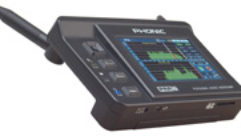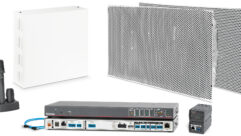
Analyzing Handheld Analyzers
Aug 1, 2005 11:31 AM,
By Mike Klasco
Some of the new handhelds go beyond mere computer interfacing.
Every sound contractor would like to have the equivalent of a telephone test set, a Swiss army knife for field use. A spectrum analyzer and maybe more that could hang from your belt and be used for checking the response and uniformity of coverage in the seating area, noise floor, max acoustic output, and other proof-of-performance job specs.
NTI’s description of its handhelds says it best for this whole product category: “Companions for maintenance of audio equipment, verification and debugging of audio installation, and improvement of live sound systems.”
NTI Acoustilyzer AL1
My first use of a spectrum analyzer was in the early 1970s. It was a Singer Panoramic. The thing took all morning to warm up and stabilize—it had tubes and weighed 60lbs. It was built in the 1960s and cost $10,000.
Now, more than 30 years later, I’ve been playing with a handful of spectrum analyzers. These handheld units cover the full hearing bandwidth and most break it up into 1/3-octave bands, which means you have about 30 bands covering 10 octaves. This bandwidth and resolution are good enough for most adjustments you might make on an equalizer.
All of the gear surveyed for this article interfaces with your computer for expanded functionality, such as recording data (LEQ, data logging, and strip chart functions). A few models can also measure reverb time and intelligibility, and some integrate a signal generator. If a generator is not built in, then test signals (pink noise, etc.) are supplied on a CD. Others offer a separate signal generator, because this would be located in the amplifier room while the handheld analyzer makes the rounds. Impedance and polarity tester functions are also included on some units.
Laboratory analyzers are expensive and awkward for field use, although some TEF Jedi Knights do take their computers with external boxes to jobs for fully characterizing and tweaking sound systems. But for many sound contracting jobs, a handheld 1/3-octave analyzer and SPL meter do nicely. When choosing a unit, considerations should include not just the ease of use in walking the seating and observing levels and tonal balance, but also intuitive operation—something even the newbie B-team guys can handle.
The frosting on the cake is that most of the latest crop of handhelds is capable of a lot more, and some morph into serious lab gear when connected to a laptop. Of course, getting the most out of these power-packed handhelds requires an understanding of acoustics and audio, and there is an opportunity here for “the monkey with a gun” to generate bad data.
All these handheld units come with a Type II mic, which has decent accuracy for field use over time and temperature. If you are concerned about traceable lab measurements or if you get involved in expert witness court work on audio matters, you will need a Type I mic and meter system, and the calibration certificate for the system (mic and electronics) to back it up. Most of the brands reviewed offer an optional Type I or can recommend one for their products (this may set you back another $1,000 or more).
On to the gear! Our focus this month is on self-contained handheld test units from Ivie, Phonic, NTI (Neutrik), Sencore, and Gold Line.

Ivie IE-33
Ivie Technologies
Ivie has been providing acoustic test equipment and commercial audio electronics for about 30 years. Its IE-10 and IE-30 handheld spectrum analyzers were in common use when Saturday Night Fever was a first-run movie. These compact units used rows of red LEDs for display.
About three years ago, Ivie launched the IE-33. This is the first miniature, handheld, calibrated measurement device delivering a broad range of acoustical measurements on an approximately 3″x 4″ color touchscreen LCD. The Ivie analyzer is really a PDA handheld computer with the Ivie hardware and firmware (mic preamp, 20-bit A/D and D/A converters, and other stuff) living in the handheld computer. Obviously, users can use all the other functions of a Windows mobile PDA as well as the acoustic instrument capabilities.
In-the-field functions of the IE-33 include realtime frequency response measurements (1/1-, 1/3-, 1/6-, or 1/24-octave resolution), sound level measurements, level variation through the club, strip chart recordings of sound level over time, polarity checking, dual trace and XY oscilloscope measurements, noise criteria (NC/NR) measurements, noise index class (NIC) measurements, a built-in signal generator, and audio level volt meter. Earlier this year the RT-60 reverb option was added.
The latest iPAQ handheld computer host offers wi-fi and Bluetooth, which has some exciting applications for the IE-33 functions. With a lot packed into 11oz., the IE-33 costs $1,647—but remember you get a pocket PC PDA in the bargain. If you already have a compatible handheld computer, then the jacket, software, and calibrated mic cost about $1,199.
I hear that Ivie is introducing some new instrumentation on a miniature platform later this year (you heard it here first!), but the company isn’t taking the wraps off of it for another month.
The Ivie is one of the most powerful instruments of the group I surveyed; it delivers very accurate measurement data. I borrowed the first release of the IE-33 about 18 months ago, and a few associates tried it in field use. After an initial learning curve, all came to love this unit, especially the great display graphics—so much that getting it back from each of the field testers became a challenge. For those who want both a lab instrument and a field instrument in one—not to mention a handheld computer/PDA—take a good look at Ivie’s IE-33.

Phonic PAA2
Phonic
Many readers will recognize Phonic as a DJ and PA equipment manufacturer. A Taiwanese company, Phonic started out building mixers and signal processors for a famous Japanese pro sound brand, and has been selling its products in the United States for many years.
The Phonic PAA2 is a handheld audio analyzer that provides the tools needed to set up any sound environment. The PAA2 consists of a self-contained handheld unit that has an approximately 2.5″x3″ monochrome display and mic. It can be readily connected to your laptop computer. The unit features 31-band realtime spectrum analysis, SPL (sound level) and line meter, internal noise generator, EQ setting program, microphone calibration and speaker phase (polarity) checking abilities.
For testing the response of a speaker, the noise generator output is sent to the sound system and the output is shown on the PAA2’s display. EQ, electronic crossover points, and other adjustments are then made. Alternatively, the included CD test disc can be used for the signal source that eliminates the umbilical cord to the sound system for walking the seating areas.
The PAA2 has a central job dial from which all functions and menus can be accessed. The unit connects to any desktop or laptop and the output display is impressive, especially on a large screen. The cost of the PAA2 is $360. Phonic will soon be offering the PAA3, and updated model with RT-60 measurement and a USB interface for desktop software, for around $470. Phonic resellers get the usual discount, making this quite a bargain and a must-have for even your junior technicians.
Gold Line
Gold Line jumped into the handheld test set market more than 20 years ago with a 10-octave band unit. Signal generators and related products followed, and eventually the company acquired the TEF analyzer from Crown.
The 30MP and the DSP30 series are portable, 30-band, 1/3-octave analyzers. The more sophisticated DSP30’s filter shape exceeds ANSI standard, the 30MP’s meets ANSI type II. Both units have RS232 ports. The 30MP is supplied with a calibrated mic. Options on the DSP30 include models with STI intelligibility testing capability and privacy testing (for masking system setup). Both tools are cased in rugged powder-coated aluminum, but at about 2lbs. these units are a handful. The 30MP costs $875, and the basic DSP30 with Windows software and mic prices at $1,687.

Sencore SoundPro SP395
Sencore
Sencore has been around for 50 years and is known to old-timers as a manufacturer of test gear for TV repairman. About 20 years ago, most consumers stopped having their TVs repaired, and Sencore started expanding into audio instrumentation, such as power amp output power testers and other specialty items. Sencore now provides a line of audio analysis tools for field installation and performance testing commercial systems, home theater systems, and production and broadcast studios.
Among Sencore’s offerings are the SoundPro SP395 and SP495. Standard features include dual phantom-powered high-gain/low-distortion microphone inputs, FFT processing, USB preamp audio interface, and built-in generator. The response analyzer offers up to 1/12-octave resolution (1/24 when connected with TerraLink software).
Optional field-upgradeable firmware modules are available, including speech intelligibility, time delay analysis (TEF functionality without the PC), multi-band decay, and noise curves. These modules add a wide range of capabilities, including adjustments of speaker coverage and cluster alignment, time delays and speaker frequency response equalization, and testing and documentation of band-specific background noise and room reverberation. Other nice capabilities you may find useful include cable tests, speaker impedance tests, polarity tests, and signal generator functions. The SP495 SoundPro is additionally equipped with an SD memory card slot, high-resolution color LCD display, digital audio outputs, and stereo recorder and impulse recorder functions.
The SoundPros are housed in aluminum cases and are portable (battery operated). Among the most sophisticated units reviewed in this survey, the SP395 SoundPro prices at $2,795, and the SP495 at $3,295.

NTI TalkBox
NTI (Neutrik Test Instruments)
NTI is a long-established brand of acoustic test equipment for lab and production line quality control. Formerly the test equipment division of Neutrik, NIT has been an independent company for more than five years.
A few years back, NTI launched the Minstruments product line with its Minirator MR1 for field use. The MR1 handheld provides an analog audio generator setup for monitoring and troubleshooting of analog audio systems. The MR1 is priced at $215.
For our survey, NTI’s newest compact acoustical analyzer, the Acoustilyzer AL1, includes a combination of acoustical and electrical features. (Existing ML1 products can also be upgraded to AL1 capabilities.) As with some of the other handhelds in this survey, the AL1’s functionality is more than 1/3-octave response with the goal of an all-in-one tool for sound and systems contractors and installers.
The realtime spectrum analyzer features selectable 1/1- and 1/3-octave bandwidths. The spectrum analyzer simultaneously provides realtime single band SPL and Leq measurements complying with the IEC 60804.
In addition to giving sound level meter instantaneous and integrated sound pressure level (SPL) measurements, the AL1 provides repeatable short time Leq and sound exposure level (SEL) test capabilities for event monitoring requirements, including Lmin and Lmax. The AL1 displays the spectrum analyzer without interrupting other ongoing sound level measurements.
Stored spectra may be averaged or combined by using the available mathematical functions. The “Max-Min” display is particularly helpful for finding dominant room modes and characterization of listening areas. The Zoom FFT allows a detailed investigation of the frequency response of audio systems, such as comb effect or speaker interactions at crossover transitions.
Reverberation time is measured in accordance with ISO3382 in octave audio bands, including smart trigger and ranging features. The test result reliability is displayed with confidence indicators. If you have measured reverb, you know that many factors from noise floor to even the radiation pattern of the noise source can shift reverb easements. It’s a nice feature for the test system to let you know how it feels about its results.
The propagation delay time measurement for speaker setups is conducted between the electrical input of the AL1 and the built-in microphone. Automatic difference calculation simplifies the verification of correct delay arrangements for larger halls and auditoriums. Besides the polarity verification for speakers and systems, the AL1 includes basic electrical functions like Level RMS, frequency, distortion (THD+N) measurement, and cable testing. The AL1 prices at $904.
An STI-PA speech intelligibility measurement option is available using a TNO-verified algorithm, which may be provided either from the included CD or by NTI’s soon-to-be-available calibrated TalkBox acoustical stimulus source.
The MiniSPL calibrated mic is for both the AL1 and ML1, as these analyzers use an external mic, which may also be extended with any standard XLR mic cable. The MiniSPL retails for $349.
The Breakdown
Most of the products I examined for this survey are of great value. Even if you are not ready to jump in and spend a grand or two, there are options for you. For example, the Phonic units cost a few hundred dollars—what you might expect to pay for just a decent sound level meter.
There is also the customer wow factor to consider. One of my associates was troubleshooting a pre-production run of speakers in China for a client and he pulled out his NTI Minirator MR1 while visiting a production line. Language gaps aside, there was no mistaking the strong impression the unit had on the factory engineers. They were impressed enough to ask how much it cost. So while these are all useful test instruments, perhaps the hidden benefit is that they are also marketing tools for your services.
The Ivie IE-33, NTI AL1, and Sencore SoundPros are sophisticated and comprehensive test systems in spite of their compactness. All of these products are insightful tools and represent a great opportunity to continue your professional growth.
For More Information
Ivie Technologies
www.ivie.com
Phonic
www.phonic.com
Gold Line
www.gold-line.com
Sencore
www.sencore.com
NTI (Neutrik Test Instruments)
www.nt-instruments.com










